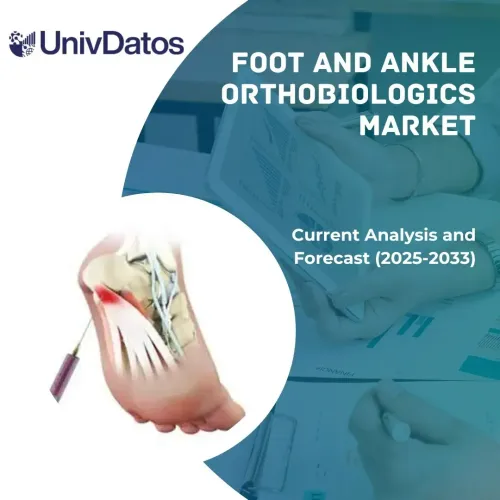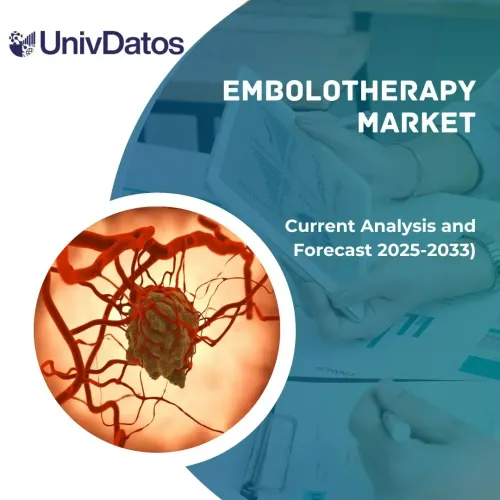- Startseite
- Über uns
- Industrie
- Dienstleistungen
- Lesen
- Kontaktieren Sie uns
Rheumatoide Arthritis Markt: Aktuelle Analyse und Prognose (2025-2033)
Schwerpunkt auf Verabreichungsweg (Oral und Parenteral); Wirkstoffklasse (Basistherapeutika (DMARDs), Nichtsteroidale Antirheumatika (NSAIDs), Kortikosteroide, Harnsäuresenkende Mittel und Andere), Vertriebsweg (verschreibungspflichtige und freiverkäufliche Arzneimittel); und Region/Land
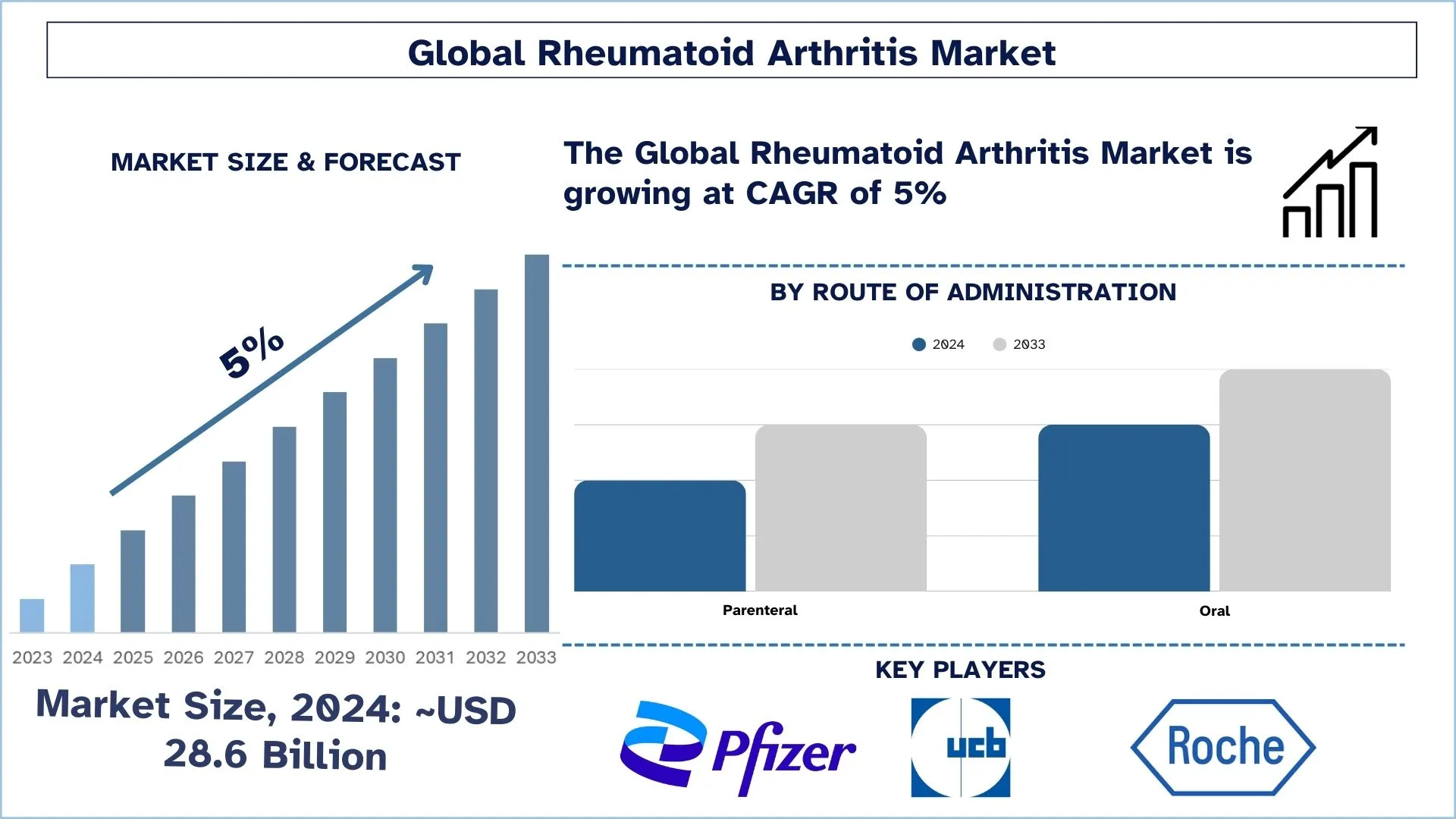
Rheumatoide Arthritis Marktgröße & Prognose
Der Markt für rheumatoide Arthritis wurde im Jahr 2024 auf etwa 82,6 Milliarden USD geschätzt und wird voraussichtlich im Prognosezeitraum (2025-2033) mit einer beträchtlichen durchschnittlichen jährlichen Wachstumsrate (CAGR) von etwa 9,5 % wachsen, was auf die steigende Anzahl von RA-Fällen zurückzuführen ist.
Rheumatoide Arthritis Marktanalyse
Rheumatoide Arthritis (RA) ist eine chronische Autoimmunerkrankung, die in erster Linie die Gelenke betrifft und Entzündungen, Schmerzen und potenzielle Gelenkschäden verursacht. Im Gegensatz zur Osteoarthritis, die durch Verschleiß entsteht, tritt RA auf, wenn das Immunsystem fälschlicherweise die Synovialis angreift – die Auskleidung der Membranen, die die Gelenke umgeben. Dies führt zu Entzündungen, die schließlich zu Knochenerosion und Gelenkverformung führen können. Zunehmende Fälle von rheumatoider Arthritis sind einer der Haupttreiber für den Markt. Zum Beispiel, betrifft RA laut Daten von census.gov etwa 1 % der Weltbevölkerung, wobei Frauen häufiger betroffen sind als Männer. Die Krankheit kann in jedem Alter auftreten, beginnt aber am häufigsten im Alter zwischen 30 und 60 Jahren.
Rheumatoide Arthritis Markttrends
In diesem Abschnitt werden die wichtigsten Markttrends erörtert, die die verschiedenen Segmente des Marktes für rheumatoide Arthritis beeinflussen, wie sie von unseren Forschungsexperten identifiziert wurden.
Steigende Nachfrage nach Biologika und Biosimilars
Biologische Arzneimittel haben die RA-Behandlung revolutioniert, indem sie auf bestimmte Bestandteile des Immunsystems abzielen. Dazu gehören Tumornekrosefaktor-(TNF-)Inhibitoren, Interleukin-Inhibitoren und B-Zell-Inhibitoren. Mit dem Auslaufen des Patents vieler Biologika werden Biosimilar-Arzneimittel – hochähnliche, kostengünstigere Versionen von Biologika – immer häufiger, was die Zugänglichkeit verbessert und die Behandlungskosten senkt.
Rheumatoide Arthritis Industriesegmentierung
Dieser Abschnitt enthält eine Analyse der wichtigsten Trends in jedem Segment des globalen Marktberichts für rheumatoide Arthritis sowie Prognosen auf globaler, regionaler und Länderebene für 2025-2033.
Das orale Segment hält den größten Anteil am Markt für rheumatoide Arthritis.
Basierend auf dem Verabreichungsweg ist der Markt in oral und parenteral unterteilt. Unter diesen hat das orale Segment in den letzten Jahren den Markt dominiert. Orale Medikamente sind im Allgemeinen einfacher zu verabreichen als parenterale Behandlungen. Patienten können orale Medikamente zu Hause einnehmen, ohne dass ein Arzt erforderlich ist, was den Komfort und die Compliance erhöht. Dies ist besonders wichtig für die Behandlung chronischer Erkrankungen wie RA, bei denen die langfristige Einhaltung der Behandlung entscheidend ist.
Es wird erwartet, dass der Markt für krankheitsmodifizierende Antirheumatika (DMARDs) eine höhere CAGR aufweisen wird als der Markt für rheumatoide Arthritis.
Basierend auf der Arzneimittelklasse ist der Markt in krankheitsmodifizierende Antirheumatika (DMARDs), nichtsteroidale Antirheumatika (NSAIDs), Kortikosteroide, Harnsäure-Medikamente und andere unterteilt. Krankheitsmodifizierende Antirheumatika (DMARDs) sind die Hauptumsatzträger auf dem Markt für die Behandlung von rheumatoider Arthritis, und ihr Wachstum wird im Prognosezeitraum voraussichtlich erheblich sein. Dieses Wachstum wird durch ein erhöhtes Bewusstsein für die Vorteile von DMARDs, eine steigende Prävalenz von rheumatoider Arthritis, eine wachsende Weltbevölkerung von fettleibigen und übergewichtigen Menschen und die weitverbreitete Einführung von DMARDs als Erstlinienbehandlung für rheumatoide Arthritis angetrieben. Diese Faktoren erhöhen zusammen die Nachfrage nach DMARDs und treiben den Markt voran.
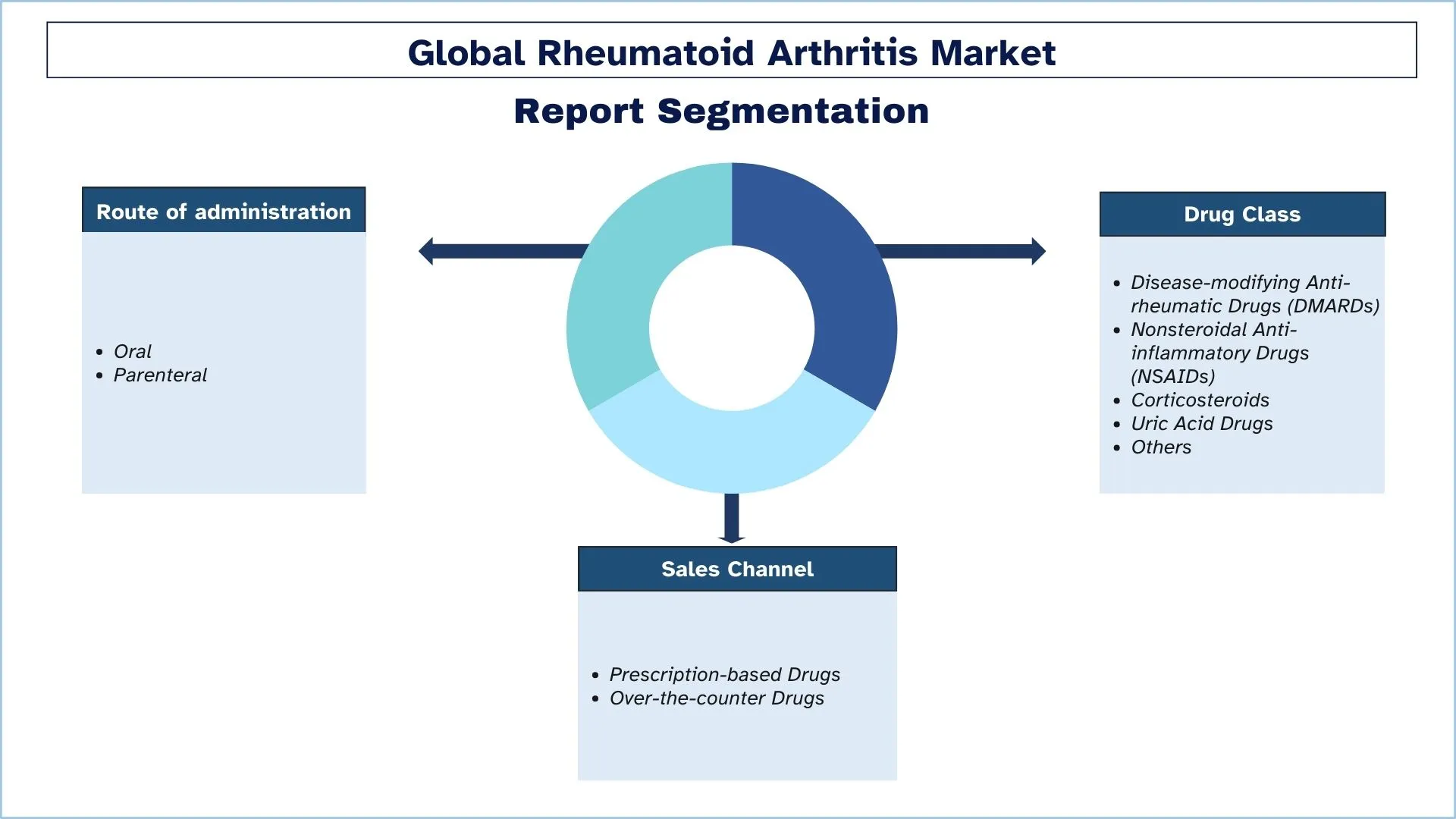
Nordamerika hat im Jahr 2024 einen bedeutenden Marktanteil.
Der Markt für rheumatoide Arthritis in Nordamerika hat in den letzten Jahren ein deutliches Wachstum erfahren, das durch verschiedene Faktoren angetrieben wird. Nordamerika, insbesondere die USA, stellt einen der größten Märkte für rheumatoide Arthritis weltweit dar. Einer der Haupttreiber des Marktes für rheumatoide Arthritis in Nordamerika ist die hohe Nachfrage nach fortschrittlichen Therapeutika, die Zunahme von Fällen von rheumatoider Arthritis und die wachsende ältere Bevölkerung. So waren beispielsweise im Jahr 2022 16,9 % der US-Bevölkerung 65 Jahre oder älter, und dieser Prozentsatz wird voraussichtlich steigen, da die Babyboomer-Generation altert, so die Daten der Centers for Disease Control and Prevention (CDC). Dieser demografische Wandel trägt zur steigenden Prävalenz altersbedingter Erkrankungen, einschließlich RA, bei. Darüber hinaus verfügt Nordamerika über einen gut etablierten Regulierungsrahmen, der die Sicherheit und Wirksamkeit von Therapeutika gewährleistet.
Die USA dominieren den nordamerikanischen Markt für rheumatoide Arthritis
Der US-Markt für rheumatoide Arthritis ist gut entwickelt und zeichnet sich aufgrund des hohen Entwicklungsstands des Marktes, des Zugangs zu Biologika und gezielten Medikamenten durch einen starken Fokus auf Innovation aus. Das Spire-Krankheitsbewusstsein, die frühen Diagnosequoten und die häufigen Forschungs- und Entwicklungsaktivitäten der meisten Pharmaunternehmen führen zu einer soliden Behandlungswelt. Führende Unternehmen wie AbbVie, Pfizer, Johnson & Johnson und Eli Lilly in ihrem Markt sind dominant und beeinflussen die sich ändernden Trends, zusätzlich zur wachsenden Nachfrage nach Biosimilars und personalisierter Medizin auf dem Markt. Auch die Kostenerstattung im Gesundheitswesen und klinische Studien der Regierung stärken die Position der Vereinigten Staaten als führendes Land in der Entwicklung der RA-Behandlung.
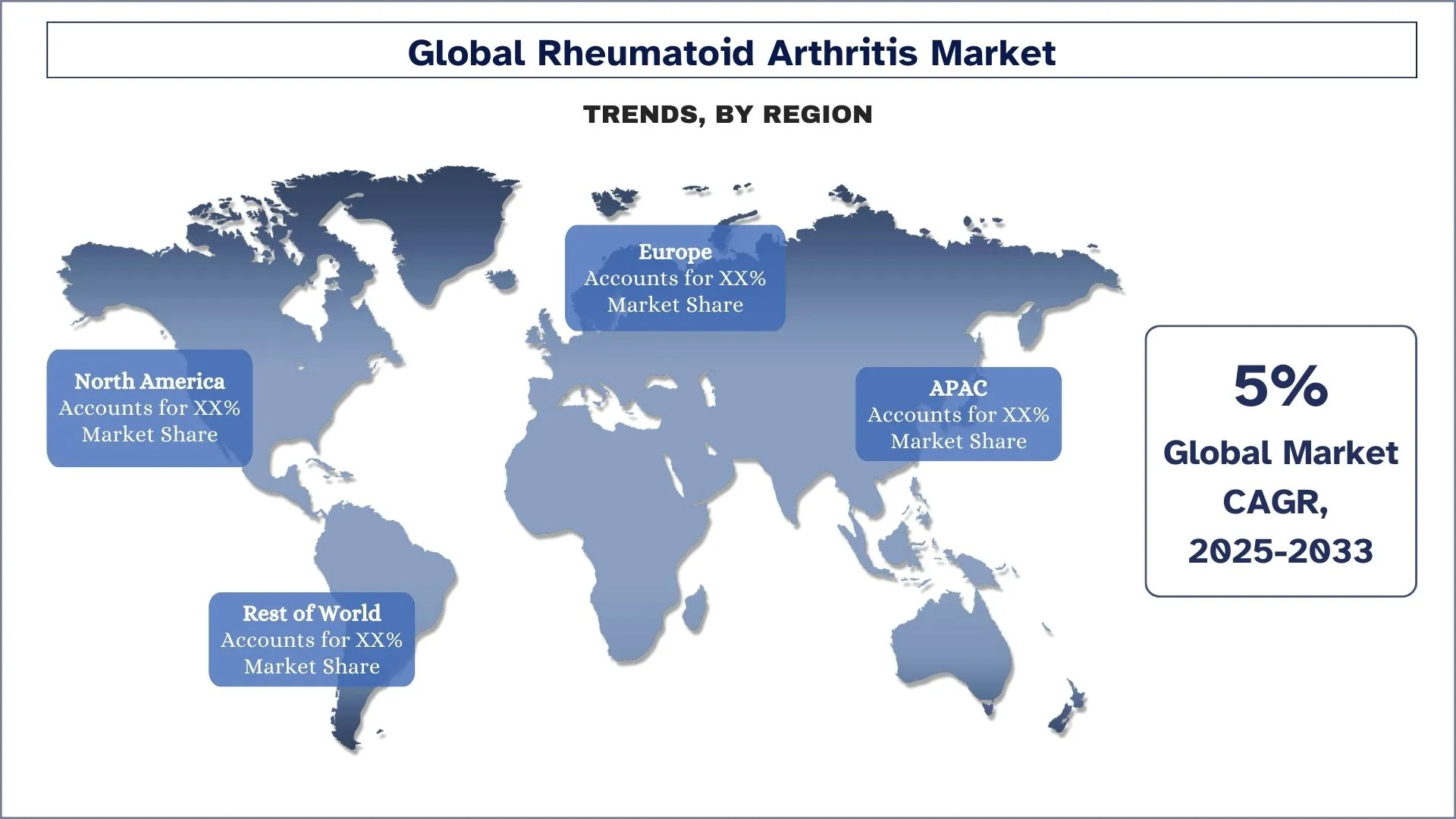
Rheumatoid Arthritis Wettbewerbslandschaft der Industrie
Der Markt für rheumatoide Arthritis ist wettbewerbsintensiv und es gibt mehrere globale und internationale Akteure. Die wichtigsten Akteure verfolgen unterschiedliche Wachstumsstrategien, um ihre Marktpräsenz zu verbessern, wie z. B. Partnerschaften, Vereinbarungen, Kooperationen, neue Produkteinführungen, geografische Expansionen sowie Fusionen und Übernahmen.
Top-Unternehmen für rheumatoide Arthritis
Einige der wichtigsten Akteure auf dem Markt sind UCB S.A.; F. HOFFMANN-LA ROCHE LTD; Pfizer Inc; ABBVIE INC.; Novartis AG; Eli Lilly and Company; Teva Pharmaceuticals, Inc.; BRISTOL-MYERS SQUIBB COMPANY; Merck & Co., Inc.; JOHNSON & JOHNSON
Jüngste Entwicklungen auf dem Markt für rheumatoide Arthritis
Im März 2024 startete Bristol Myers Squibb eine Initiative im Wert von 1,8 Millionen USD, um die sozioökonomischen Determinanten der Gesundheit (SDoH) in vier Ländern anzugehen – Brasilien, Indien, Thailand und Großbritannien – mit ungedecktem Patientenbedarf. Die neuen Zuschüsse für gesundheitliche Chancengleichheit erweitern das langfristige Engagement des Unternehmens, bis 2025 150 Millionen USD in gesundheitliche Chancengleichheit zu investieren.
Im Oktober 2023 vereinbarte Alfasigma S.p.A. die Übernahme des Jyseleca-Geschäfts von Galapagos, einem multinationalen Biotechnologieunternehmen mit Sitz in Belgien, das sich auf die Entwicklung revolutionärer Immunologie- und Onkologiebehandlungen spezialisiert hat.
Im Juli 2023 erhielt Boehringer Ingelheim International GmbH die von der US-amerikanischen Zulassungsbehörde FDA zugelassene Cyltezo (Adalimumab-adbm), ein austauschbares Biosimilar zu HUMIRA, zur Behandlung verschiedener chronisch-entzündlicher Erkrankungen, einschließlich RA in den USA.
Berichterstattung über den Markt für rheumatoide Arthritis
Berichtsattribut | Details |
Basisjahr | 2024 |
Prognosezeitraum | 2025-2033 |
Wachstumsdynamik | Beschleunigung mit einer CAGR von 9,5 % |
Marktgröße 2024 | 82,6 Milliarden USD |
Regionale Analyse | Nordamerika, Europa, Asien-Pazifik, Rest der Welt |
Wichtigste beitragende Region | Es wird erwartet, dass Nordamerika im prognostizierten Zeitraum am stärksten wachsen wird. |
Wichtige abgedeckte Länder | USA, Kanada, Deutschland, Frankreich, Großbritannien, Spanien, Italien, China, Japan und Indien |
Profilierte Unternehmen | UCB S.A.; F. HOFFMANN-LA ROCHE LTD; Pfizer Inc; ABBVIE INC.; Novartis AG; Eli Lilly and Company; Teva Pharmaceuticals, Inc.; BRISTOL-MYERS SQUIBB COMPANY; Merck & Co., Inc.; JOHNSON & JOHNSON |
Berichtsumfang | Markttrends, Treiber und Beschränkungen; Umsatzschätzung und -prognose; Segmentierungsanalyse; Angebots- und Nachfrageanalyse; Wettbewerbslandschaft; Unternehmensprofilierung |
Abgedeckte Segmente | Nach Verabreichungsweg; Nach Arzneimittelklasse, Nach Vertriebskanal; Nach Region/Land |
Gründe für den Kauf des Marktberichts für rheumatoide Arthritis:
Die Studie umfasst eine Marktdimensionierungs- und Prognoseanalyse, die von authentifizierten wichtigen Branchenexperten validiert wurde.
Der Bericht bietet einen schnellen Überblick über die Gesamtleistung der Branche auf einen Blick.
Der Bericht umfasst eine detaillierte Analyse prominenter Branchenkollegen mit einem primären Fokus auf wichtige Unternehmenskennzahlen, Produktportfolios, Expansionsstrategien und jüngste Entwicklungen.
Detaillierte Untersuchung von Treibern, Beschränkungen, wichtigen Trends und Chancen, die in der Branche vorherrschen.
Die Studie deckt den Markt umfassend über verschiedene Segmente hinweg ab.
Tiefgehende regionale Analyse der Branche.
Anpassungsoptionen:
Der globale Markt für rheumatoide Arthritis kann gemäß den Anforderungen oder anderen Marktsegmenten weiter angepasst werden. Darüber hinaus versteht UnivDatos, dass Sie möglicherweise Ihre eigenen geschäftlichen Anforderungen haben. Zögern Sie daher nicht, uns zu kontaktieren, um einen Bericht zu erhalten, der Ihren Anforderungen vollständig entspricht.
Inhaltsverzeichnis
Forschungsmethodik für die Marktanalyse von rheumatoider Arthritis (2023-2033)
Wir haben den historischen Markt analysiert, den aktuellen Markt geschätzt und den zukünftigen Markt des globalen Marktes für rheumatoide Arthritis prognostiziert, um seine Anwendung in wichtigen Regionen weltweit zu bewerten. Wir haben umfassende Sekundärforschung durchgeführt, um historische Marktdaten zu sammeln und die aktuelle Marktgröße zu schätzen. Um diese Erkenntnisse zu validieren, haben wir zahlreiche Ergebnisse und Annahmen sorgfältig geprüft. Darüber hinaus haben wir ausführliche Primärinterviews mit Branchenexperten entlang der Wertschöpfungskette für rheumatoide Arthritis geführt. Nachdem wir die Marktzahlen durch diese Interviews validiert hatten, verwendeten wir Top-Down- und Bottom-Up-Ansätze, um die Gesamtmarktgröße zu prognostizieren. Anschließend wendeten wir Marktaufschlüsselungs- und Datentriangulationsmethoden an, um die Marktgröße von Industriesegmenten und -untersegmenten zu schätzen und zu analysieren.
Markt Engineering
Wir haben Datentriangulationstechniken eingesetzt, um die Gesamtmarktschätzung zu finalisieren und präzise statistische Zahlen für jedes Segment und Untersegment des globalen Marktes für rheumatoide Arthritis abzuleiten. Wir haben die Daten in mehrere Segmente und Untersegmente aufgeteilt, indem wir verschiedene Parameter und Trends analysiert haben, darunter Verabreichungsweg, Arzneimittelklasse, Vertriebskanal und Regionen innerhalb des globalen Marktes für rheumatoide Arthritis.
Das Hauptziel der globalen Marktstudie über rheumatoide Arthritis ist
Die Studie identifiziert aktuelle und zukünftige Trends auf dem globalen Markt für rheumatoide Arthritis und bietet strategische Einblicke für Investoren. Sie hebt die Attraktivität regionaler Märkte hervor und ermöglicht es den Marktteilnehmern, unerschlossene Märkte zu erschließen und einen First-Mover-Vorteil zu erzielen. Weitere quantitative Ziele der Studien sind:
Marktgrößenanalyse: Bewertung der aktuellen und prognostizierten Marktgröße des globalen Marktes für rheumatoide Arthritis und seiner Segmente in Bezug auf den Wert (USD).
Marktsegmentierung für rheumatoide Arthritis: Die Studie segmentiert den Markt nach Verabreichungsweg, Arzneimittelklasse, Vertriebskanal und Region.
Regulierungsrahmen & Wertschöpfungskettenanalyse: Untersuchung des Regulierungsrahmens, der Wertschöpfungskette, des Kundenverhaltens und der Wettbewerbslandschaft der Industrie für rheumatoide Arthritis.
Regionale Analyse: Durchführung einer detaillierten regionalen Analyse für Schlüsselregionen wie den asiatisch-pazifischen Raum, Europa, Nordamerika und den Rest der Welt.
Unternehmensprofile & Wachstumsstrategien: Unternehmensprofile des Marktes für rheumatoide Arthritis und die von den Marktführern angewandten Wachstumsstrategien, um den schnell wachsenden Markt zu erhalten.
Häufig gestellte Fragen FAQs
F1: Wie groß ist der aktuelle Markt für rheumatoide Arthritis und welches Wachstumspotenzial hat er?
Im Jahr 2024 wird der globale Markt für rheumatoide Arthritis auf etwa 82,6 Milliarden USD geschätzt und soll bis 2033 mit einer CAGR von 9,5 % wachsen.
F2: Was sind die treibenden Faktoren für das Wachstum des Marktes für rheumatoide Arthritis?
Der weltweite Anstieg von RA-Fällen wird durch Faktoren wie alternde Bevölkerungen, sitzende Lebensweisen und genetische Veranlagungen vorangetrieben. Dieser wachsende Patientenpool treibt die Nachfrage nach wirksamen Behandlungen an und erweitert den RA-Therapeutika-Markt.
F3: Welcher Markt hat den größten Anteil am Markt für rheumatoide Arthritis nach Verabreichungsweg?
Die Kategorie Oral hält derzeit den größten Marktanteil im Segment der Verabreichungswege.
Q4: Was sind die wichtigsten Trends im Markt für Rheumatoide Arthritis?
Der Ablauf von Patenten für mehrere Biologika hat Wege für die Biosimilar-Entwicklung eröffnet. Diese kostengünstigen Alternativen gewinnen an Bedeutung, insbesondere in Schwellenmärkten, wodurch moderne RA-Behandlungen zugänglicher und erschwinglicher werden.
F5: Welche Region wird den Markt für rheumatoide Arthritis dominieren?
Q6: Was sind die größten Herausforderungen im Markt für rheumatoide Arthritis?
Trotz ihrer Wirksamkeit sind Biologika oft mit hohen Kosten verbunden, was für viele Patienten ein Problem der Erschwinglichkeit darstellt. Diese finanzielle Barriere kann zu einem verzögerten Behandlungsbeginn oder mangelnder Therapietreue führen, was sich negativ auf die Patientenergebnisse auswirkt.
F7: Wer sind die Top-Akteure auf dem globalen Markt für rheumatoide Arthritis?
Zu den führenden Unternehmen, die Innovationen bei rheumatoider Arthritis vorantreiben, gehören:
• UCB S.A.
• F. HOFFMANN-LA ROCHE LTD
• Pfizer Inc
• ABBVIE INC.
• Novartis AG
• Eli Lilly and Company
• Teva Pharmaceuticals, Inc.
• BRISTOL-MYERS SQUIBB COMPANY
• Merck & Co., Inc.
• JOHNSON & JOHNSON
F8: Was sind die aufkommenden Investitionsmöglichkeiten im globalen Markt für Rheumatoide Arthritis-Therapeutika?
• Der Markt entwickelt sich mit Chancen in Biosimilars, oralen JAK-Inhibitoren und zielgerichteten synthetischen DMARDs, die eine verbesserte Wirksamkeit und Patientencompliance bieten.
• Investoren konzentrieren sich zunehmend auf F&E-Partnerschaften, Pipeline-Assets mit differenzierten Mechanismen und digitale Gesundheitslösungen für die RA-Überwachung und -Behandlung.
• Die Expansion in Schwellenländer mit hohem ungedecktem medizinischem Bedarf bietet ebenfalls erhebliches Wachstumspotenzial.
F9: Wie können Pharmaunternehmen im Markt für Medikamente gegen rheumatoide Arthritis einen Wettbewerbsvorteil erhalten?
• Unternehmen können wettbewerbsfähig bleiben, indem sie über TNF-Inhibitoren hinaus Innovationen entwickeln, in die Biomarker-Forschung für personalisierte Behandlungen investieren und die Zulassungsverfahren weltweit beschleunigen.
• Die Stärkung der Real-World-Evidence (RWE)-Generierung, die Verbesserung von Patientenzugangsprogrammen und die Einführung strategischer Preismodelle sind der Schlüssel zum langfristigen Erfolg.
• Die Nutzung digitaler Engagement-Plattformen und Telemedizin kann auch die Patientenadhärenz und -ergebnisse verbessern und die Markentreue fördern.
Verwandt Berichte
Kunden, die diesen Artikel gekauft haben, kauften auch






